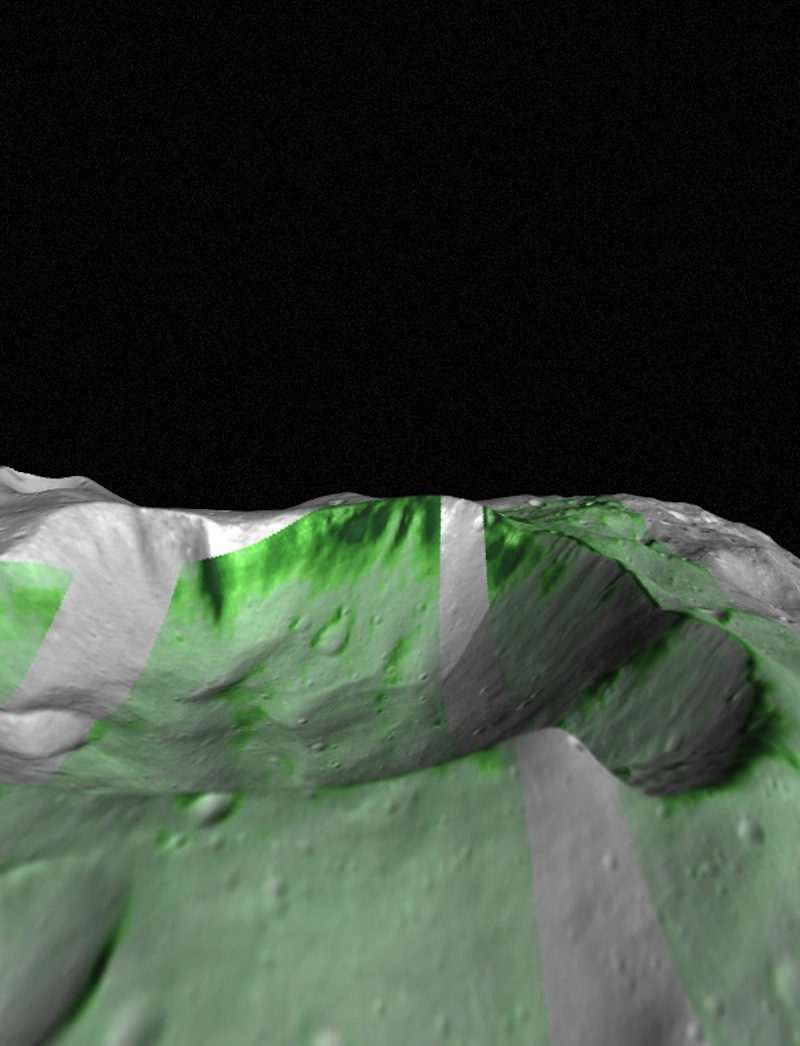Mystery of Huge Asteroid Vesta's Formation Deepens

The discovery of mysterious rocks on the brightest large asteroid in the solar system, Vesta, deepens the mystery surrounding the huge object's origins, researchers say.
Vesta is the second-largest asteroid in the solar system. The 330-mile-wide (530-kilometer) protoplanet is also the brightest large asteroid, with a surface about three times more luminous than Earth's moon.

The vast size of Vesta helped it hold onto its heat during its birth, enabling lighter molten rock to float outward while denser rock sank inward. As such, Vesta developed an onion-like structure like Earth's, differentiated into an outer crust, a central core and a mantle layer between the two. [Photos of Asteroid Vesta by NASA's Dawn Probe]
Cosmic impacts regularly blast rocks off Vesta. A class of meteorites known as diogenites are thought to come from Vesta's mantle or lower crust, and sometimes possess substantial amounts of a green mineral known as olivine, a major ingredient of Earth's upper mantle. As such, investigators expected to find olivine in places on Vesta where large impacts unearthed deeply buried rocks.
Now scientists have spotted olivine on Vesta, but not where it was expected it to be. Instead of discovering olivine in Vesta's deep southern craters, they surprisingly found it near shallower northern craters, mixed with the most common type of rock found on Vesta's surface. This suggests olivine might exist within Vesta's crust instead of deeper within its mantle.
Researchers analyzed data from NASA's Dawn spacecraft, which became the first probe to visit Vesta when it orbited the protoplanet in 2011 and 2012.
"We were searching for olivine since the beginning of Dawn's orbital phase, because we know how important olivine is to understanding the differentiation processes of early bodies of the solar system," said study author Maria Cristina De Sanctis, a planetary scientist at the Institute for Astrophysics and Space Planetology in Rome.
Breaking space news, the latest updates on rocket launches, skywatching events and more!
Unexpectedly, the investigators did not detect olivine in any of Vesta's deep southern basins, such as the crater Rheasilvia, which is about 12 miles (19 kilometers) deep, and Veneneia, which is about 7.5 miles (12 km) deep. Instead, Dawn found rocks made of 50 to 80 percent olivine in patches hundreds of feet large in the areas surrounding two smaller northern craters — Arruntia, which is about 1.2 miles (2 km) deep, and Bellicia, which is about 4 miles (6.6 km) deep.
The researchers do not think the impacts that created Arruntia and Bellicia directly excavated this olivine from its origins within Vesta. Rather, they suspect this olivine was dug up by impacts creating earlier, larger craters nearby and then excavated again by the collisions that created Arruntia and Bellicia. Still, this olivine was apparently mixed with a rock type known as howardite, the most common surface material on Vesta, suggesting it might indeed be a component of the asteroid's crust.
Olivine might be present in the matter surrounding the deep southern craters as well. However, olivine is very difficult to detect in the presence of pyroxenes, which are common on Vesta. Olivine could make up 25 to 30 percent of the rocks surrounding the deep southern craters and still get obscured there by pyroxenes, researchers say.

These findings challenge how scientists currently think Vesta formed. There are two main models for the evolution of Vesta. One involves the asteroid being covered with an ocean of magma that eventually cooled down to form a core, mantle and crust, with large amounts of olivine located in the mantle very deep below the crust. The other posits that Vesta formed with pockets of magma slowly crystallizing beneath the surface to form bodies of rock called plutons, with olivine located at the base of or within Vesta's crust.
"Some evidence favors the magma-ocean model, like the large area of the olivine patch, while some other evidence, such as the higher depths, favor the pluton models," De Sanctis said. "The evidence that we have is difficult to reconcile in only one standard model for Vesta formation."
Instead, new models of Vesta's formation may be hybrids of the current standard models.
"Our work tells us that Vesta's evolution was complex, more complex than was expected before Dawn," De Sanctis told SPACE.com. "This does not mean that we do not know anything about its evolution, but only that we need to develop more complex models for Vesta."
The scientists detailed their findings online Nov. 6 in the journal Nature.
Follow us @Spacedotcom, Facebook or Google+. Originally published on SPACE.com.
Join our Space Forums to keep talking space on the latest missions, night sky and more! And if you have a news tip, correction or comment, let us know at: community@space.com.

Charles Q. Choi is a contributing writer for Space.com and Live Science. He covers all things human origins and astronomy as well as physics, animals and general science topics. Charles has a Master of Arts degree from the University of Missouri-Columbia, School of Journalism and a Bachelor of Arts degree from the University of South Florida. Charles has visited every continent on Earth, drinking rancid yak butter tea in Lhasa, snorkeling with sea lions in the Galapagos and even climbing an iceberg in Antarctica. Visit him at http://www.sciwriter.us
